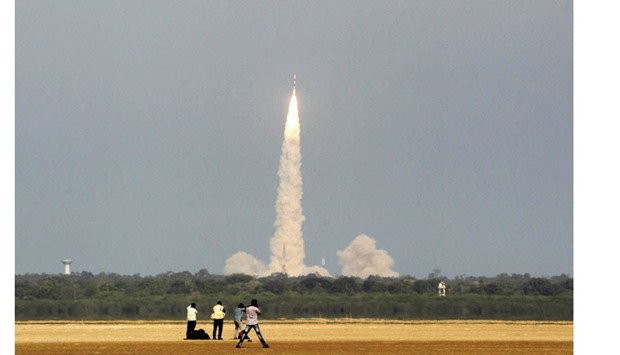
The Polar Satellite Launch Vehicle (PSLV-C32) carrying the navigation satellite IRNSS-1F is launched from Sriharikota yesterday.
India yesterday put into orbit its sixth navigation satellite called IRNSS-1F with its own rocket in copybook style.
With this success, India has moved closer towards joining a select group of nations possessing its own satellite-based navigation system.
Named the Indian Regional Navigation Satellite System (IRNSS), it consists of a constellation of seven satellites, of which the sixth was put into orbit yesterday.
Immediately after the 1,425kg IRNSS-1F satellite was injected into space by the Polar Satellite Launch Vehicle (PSLV-C32) rocket, scientists at the mission control centre clapped their hands in joy.
“The sixth navigation satellite has been put into orbit successfully. The seventh navigation satellite is expected to be launched some time next month,” Indian Space Research Organisation chairman A S Kiran Kumar said.
ISRO will raise the satellite to its home slot over the next couple of days.
The satellite, with a design life span of 12 years, has two payloads for navigation and ranging.
The navigation payload of IRNSS-1F will transmit navigation service signals to the users. This payload will be operating in L5-band and S-band. A highly accurate rubidium atomic clock is part of the navigation payload of the satellite.
The ranging payload of IRNSS-1F consists of a C-band transponder (automatic receivers and transmitters of radio signals) which facilitates accurate determination of the range of the satellite. IRNSS-1F also carries Corner Cube Retro Reflectors for laser ranging.
“The launch campaign for the seventh navigation satellite has begun at the first launch pad. The next navigation satellite launch will be a milestone for ISRO,” said P Kunhikrishnan, director of Satish Dhawan Space Centre.
Till date, India has launched six regional navigational satellites (IRNSS-1A, 1B, 1C, ID, 1E and 1F) as part of a constellation of seven satellites to provide accurate position information service to users across the country and the region, extending up to an area of 1,500km.
Though the full system comprises nine satellites - seven in orbit and two on the ground as stand-by, the navigation services could be made operational with four satellites, ISRO officials had said earlier.
Each satellite costs about Rs1.5bn while the PSLV-XL version rocket costs about Rs1.3bn. The seven rockets would entail an outlay of about Rs91bn.
The entire IRNSS constellation of seven satellites is planned to be completed in 2016.
The first satellite, IRNSS-1A, was launched in July 2013, the second, IRNSS-1B, in April 2014, the third on October 2014, the fourth in March 2015 and the fifth in January this year.


